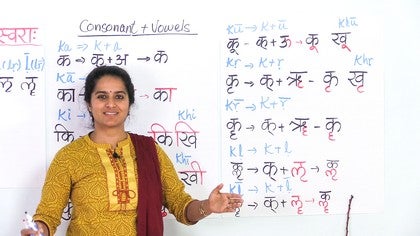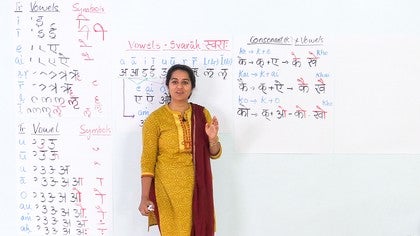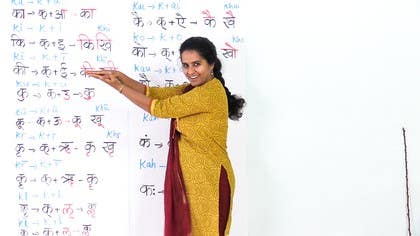Description
About This Video
Transcript
Read Full Transcript
I am adding a few more sounds into your existing vocabulary of Sanskrit sounds because then we start getting a feel of how the independent letters of the Sanskrit language combine with the different vowels and then start laying out a different pattern of sound combinations, of creation. So what we have seen thus far is the combination of the consonant K with the different vowels. So we had there, so that was the consonant K with the vowels, we had K plus a which gave us the K plus a, ka, k plus i, ki, k plus i, ki, k plus u, ku, k plus u, ku, ku plus r, ku, ku plus r, ku, ku plus l, ku, ku plus a, ku, ku plus i, ki, ku plus u, ku, ku, ku plus ou, ku, ku plus um, kum, ku plus a, ka, ku. Got that? Now let's see if we can sort of recognize the drawing that corresponds to these different combinations.
So we have the ê°?, 기, 기, 구, 기, 기, 기, 기, 기, 기, 기, 기, 기, 기, 기, ê³ , ê°?, 기, 기, 기, 기. Sit with the sounds. My suggestion to you is that when we study any language, these languages impact our brain and our being in very unique ways. With Sanskrit, because of the transparency that permeates this language, at the level of its sound, its picture, its word formations, etc., if you sit with this language and the letters and the sounds of this language, it allows to start making certain changes in your being. So when you study Sanskrit, especially Sanskrit, I can say that because it is something which has been a personal experience. So when you study Sanskrit, don't just study it as you would like to study any other language. Study it with an open heart. Study it as a meditation. Study it as a way of discovering truth. Study it as a way to fine-tune your consciousness and in that Sanskrit becomes a yoga in itself. The more you open yourself to it, the more it starts working itself within you to bring about an alignment. So what we'll do now is that we will try to see the letter and then try and draw it with our bodies. It's a different way of learning it. If you are a very academic type, then it's good. You do it the way you like just to practice writing it. But I think because the quality of Sanskrit is that it moves our being, you could just try this experiment once to free yourself, decondition yourself or uncondition yourself and say let me dance with this letters and see what it does. But you need to remember that since we are facing each other, don't try and copy me. Look at the letter for yourself, close your eyes and do it as if you would be writing it independently. Because if you copy me, then you would get it backwards and that would be more confusing. So just see the letter curve, visualize it in your mind, then close your eyes and then draw it with your body. You can use one hand, so if you're a right-hander, you might like to just draw it big like that. If you're a left-hander person, you can draw it with your left hand and then you can draw it with both hands. So as you draw it, make the sound also. So it's almost like a martial art. You will see that again. Say that again. How's that? Discover your own, discover your own rhythm, your own dance. So we'll do it with every letter. So see the letter, focus on it, close your eyes, sound it and then draw it with your being. We move on to the next one. So see the ah, the ka and just remember that it's that same letter with an extra stick. So close your eyes and then try and draw it. This one could also be quite fun to do with two hands. So you draw it out the letter with one hand and then you use the other hand to draw the the vowel attached to it. Okay, so that is your ka. The next one is the key. So in your mind's eye, position the stick of the key that comes before the letter and you can use your left hand to represent that. So you get, draw the stick, draw the letter and then make that connection. Key. So stick, letter, hoop and the line on top. Key. Yeah, we do the next one. So visualize the letter, see it clearly, close your eyes, dance to it. So the stick comes after. So k, stick, e, key. Got that? Key. Very nice. The next one is the ku. So it's the k with a small ooh below it, the small almost like a comma, upward turned comma. So we do the kuh and then oh and then you put the line on top. Ku. Got it? Now the next one, visualize, see the letter first, close your eyes, visualize it in your mind's eye and then draw it. Kuh, ooh. Doing very well. We move on. The next vowel is the kruh. The kuh combined with the ruh, kruh. So again, see the letter there clearly. Close your eyes, visualize it in your mind's eye and then draw it out. Kuh, ruh is the small c, kruh.
That's it. Very nice. The next sound, kruh is the kuh with a long ruh. See the picture. Close your eyes and then draw it. Kuh, it's a double c below, kruh. Lovely. The next one, kruh. Visualize, see it here first. Now close your eyes, visualize it and then draw it. So it's a combination of the kuh which gets a bit squashy and then below it the loving luh like a heart almost and then a c below it. Kuh, did you get that? You can open your eyes and do it if that is more convenient. Just do what you feel will give you more confidence. The good thing about learning these letters is that once you have learned it, you would have learned how to read and speak and also to write these letters for eternity because they are going to change. There is only one sound that is represented by one letter. So if you've got it once, you've got it for all times. I'll just share with you about a friend who had a problem with his, he was dyslexic in the English language and that is because in English there is no direct combination between or there is no direct connection between the way you see something and you read it and you write it and sometimes it can leave a person quite confused. But in the Sanskrit language, every letter corresponds to a single sound. So if you know how to write it, you know how to sound it and if you know what it sounds like, you also would know how to write it. That sometimes can help to bring in a great deal of confidence in the individual. So what happened to this friend is that he started studying Sanskrit and somewhere within his being, it helped to align certain patterns which were otherwise confused and once that happened, he found that when he went back to English, he was not dyslexic anymore. So these are certain subtle benefits that one can experience with the study of Sanskrit. So we move on now. We've seen the klur, we'll do the long one which is the klur with a double C below the half heart. So close your eyes, do it klur and then the half heart below it and the double C klur and draw the line. The drawing the line is a it's a very releasing movement. You should try it out. The next is the K. So see the letter, visualize it in your mind's eye and go for it. So we do it klur, you can put the line and then the antenna on the head. K, very good. There's only one antenna on the head of this one. It's a K. The kai as you see has a double antenna. So see it, close your eyes and do it. K, I, the double antenna. It can really be quite meditative so try it. Then we have the letter klur which is the klur and then it has this extra bar with the antenna on the head. So you draw it klur, the bar, oh. The klur, the next letter or the next syllable has a double antenna. So see it in your mind's eye, close your eyes and do it. K, ou and kau.
Hold the sound, hold the picture of it, hold the feeling of it. The last two letters or the last two syllables here, the letter would be just the k, but when you combine it with the vowel it then starts becoming like a syllable almost. So we have the kum, so it's the kur with the dot on the head. So do it, kur, draw the line, um. It's almost as if you're ringing a bell, kum. In India we do that at the temples. So just imagine that you're nailing in a point. Okay, do that once more, kur, draw the line and um. If you want to have some more fun with it you can imagine that you're tapping into the secret of the universe with that kum, then become receptive. And the final, the kah is the kur with the two dots beside it. So it goes kur, put the two dots, kah and the line across. Once more, kur, the two dot, tuk and the line across, kah. I just propose that we play a small game maybe just with a few letters. Close your eyes and I will call out a syllable and see if you can picture it for yourself. Yeah, you try that. So close your eyes and now do the letter kur. Okay, open your eyes and see whether you got it correct. Yeah, another one. So close your eyes and then draw the letter ko. Did you get it? Open your eyes. Yeah, one last one. Okay, so close your eyes, see if you can get the letter ko. Did you draw it? Yeah, open your eyes and check it. What you could do is to try and help yourself remember these combinations. You could just try to write them out, write them out big because that helps. Write it out big and you can paste cards in places that you are in your house. So you can place it on your bathroom wall or on a cupboard or something like that. So when you wake up, you can see it. The more times it is reinforced within your system, the sooner will you absorb this language within your being. So try and expose yourself to this as much as you can at the level of the sounds. Every time you sound it, now that we see what it looks like, try and connect it immediately to the picture of that letter. Okay, so if you say ko, spontaneously try and get the image of that particular combination of ko. And yeah, I can assure you, if you just do this, if every day you just take two, it will take you eight days to get this whole combination. And once you know the way the different symbols add on, it's the same way that they add on with all the different consonants. There is no change in that. Except for one or two, which are exceptions, but that, the more you studied, the more it will come. You need not worry specifically about that. Focus on the general nature of the way these vowels combine with the consonants and it will come to you. It will come to you because you want to know it. Yeah? Okay, so I wish you all the very best. Stay with these sounds, enjoy it and see you again.






You need to be a subscriber to post a comment.
Please Log In or Create an Account to start your free trial.